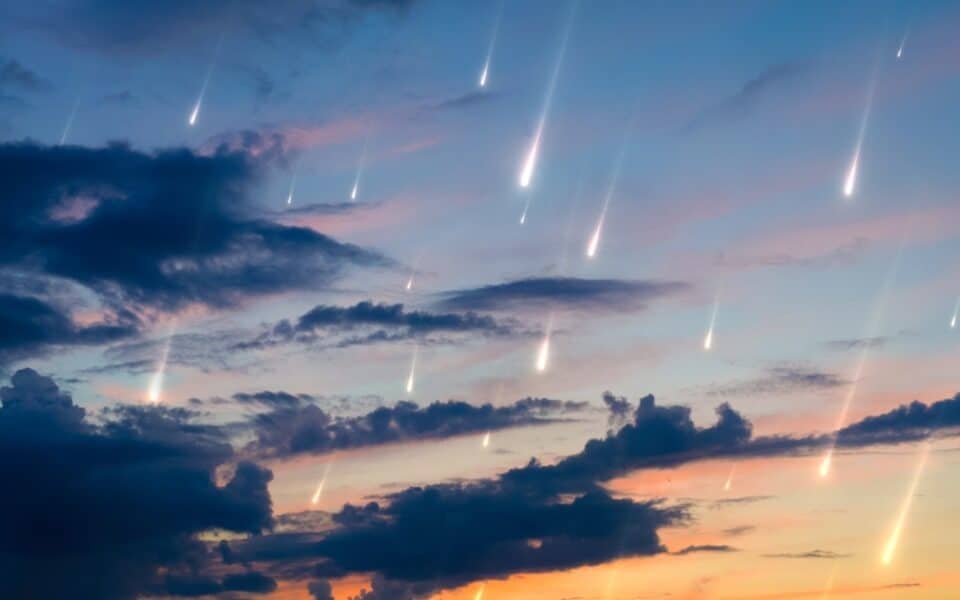The night sky becomes a canvas of fleeting lights. From May 4 to 6, the Eta Aquariids meteor shower, formed by fragments of the iconic Halley’s Comet, reaches its peak, delivering a celestial spectacle visible across the globe. In the Southern Hemisphere, conditions are particularly favorable, with the shower’s radiant positioned high, promising up to 20 meteors per hour in areas free of light pollution. Astronomers and enthusiasts are gearing up for early morning vigils, armed with blankets and patience, to catch the brilliant streaks crossing the firmament.
This annual phenomenon has deep cosmic roots, tied to one of the Solar System’s most famous objects. To make the most of it, observers should seek dark locations far from city lights and focus on the constellation Aquarius. In 2025, conditions are optimal, with the waxing crescent Moon setting before dawn, ensuring clear skies for viewing.
- Best time: Between 2 a.m. and 4 a.m., when the radiant is most visible.
- Recommended location: Rural or remote areas with minimal artificial light.
- Equipment needed: None, just keen eyes and patience.
- Extra tip: Bring warm clothing, as early mornings can be chilly.
Cosmic origins of the spectacle
The Eta Aquariids meteors are debris from Halley’s Comet, a celestial body that orbits the Sun every 76 years. These fragments, ranging from dust grains to small pebbles, enter Earth’s atmosphere at speeds up to 66 kilometers per second, burning up and creating the luminous trails that captivate onlookers. Earth crosses this debris stream annually, producing two meteor showers: the Eta Aquariids in May and the Orionids in October. Halley’s Comet, identified in the 17th century by Edmond Halley, is one of astronomy’s most studied objects, and its debris offers clues about the Solar System’s formation.
Each meteor tells a story billions of years old. Formed roughly 4.5 billion years ago, these fragments are remnants of the Solar System’s early days. As they burn in the atmosphere, they release data that scientists analyze through techniques like spectroscopy, which reveals the chemical makeup of meteoroids. On rare occasions, larger fragments create fireballs, brilliant phenomena visible even in areas with some light pollution.
The event also bridges science and history. Edmond Halley’s precise prediction of the comet’s orbit in 1705 was a milestone in modern astronomy. Its passages, such as those in 1910 and 1986, provided critical data, with the next expected in 2061. Until then, showers like the Eta Aquariids keep scientists and amateurs connected to this cosmic legacy.
Ideal conditions for 2025
The nights of May 4 to 6 offer the best opportunities to observe the Eta Aquariids in 2025. During this period, the waxing crescent Moon sets before dawn, leaving the sky dark enough to highlight even fainter meteors. The constellation Aquarius, home to the shower’s radiant, rises higher in tropical latitudes, favoring countries like Brazil, Australia, and parts of Africa.
- Meteor rate: Up to 20 per hour in the Southern Hemisphere, 10 to 15 in the Northern Hemisphere.
- Optimal time: 2 a.m. to 4 a.m., with the radiant at a high position.
- Ideal conditions: Clear skies, no clouds, and low light pollution.
- Helpful tools: Apps like Stellarium to locate the Aquarius constellation.
Visibility, however, hinges on weather conditions. Rain or cloudy skies can obstruct viewing, making it essential to check forecasts in advance. Rural areas, such as Brazil’s interior or Australia’s outback, provide the best conditions, with pristine skies that showcase the shower’s intensity. Urban observers may struggle, as light pollution dims fainter meteors.
For those planning to watch, adapting eyes to darkness is key. Arriving at the site at least 30 minutes early enhances visual perception. Avoiding phone screens or flashlights preserves night vision, allowing viewers to spot the shower’s highlights, including rare “earthgrazers” that create long, glowing trails near the horizon.
Science behind the meteors
The Eta Aquariids meteor shower is more than a visual treat; it’s a window into the Solar System’s past. Each meteoroid that burns in the atmosphere carries data about comets, which are relics of the system’s formative stages. Scientists use tools like spectrometers to study the light emitted by meteors, identifying elements such as carbon, iron, and silicates.
Studying these fragments also aids in protecting space infrastructure. Monitoring networks, like Brazil’s Exoss, track meteoroid orbits to predict peak activity and prevent collisions with satellites or space stations. In 2025, Exoss plans to expand its monitoring stations, adding new cameras and sensors for more accurate data collection.
Data gathered during the Eta Aquariids are shared globally. Organizations like the International Meteor Organization (IMO) compile information from scientists and amateurs, creating detailed maps of meteor showers. These collaborative efforts underscore the phenomenon’s importance to modern science, blending cutting-edge technology with public participation.
Citizen science in meteor tracking
Brazil’s Exoss Network exemplifies how citizen science drives meteor research. With stations at sites like the National Observatory in Rio de Janeiro and the Sertão de Itaparica Astronomical Observatory in Pernambuco, the initiative collects images and videos from associates and the public. During the Eta Aquariids, these contributions are invaluable, helping map the shower’s intensity and distribution.
- How to contribute: Submit meteor photos or videos to the Exoss website.
- Recommended equipment: DSLR cameras or smartphones with long-exposure apps.
- Monitoring locations: Stations in Brazil, the United States, and Australia.
- Impact of contributions: Data aid in orbit prediction and satellite protection.
Amateurs play an increasingly vital role in astronomy. In 2024, images captured by observers in Colorado, USA, gained attention on specialized portals. In Brazil, Exoss encourages participation, particularly in regions like the North and Northeast, where it plans to install new stations. Anyone with a basic camera can contribute, provided images are clear and include details on location and time.
Millennia of meteor fascination
Meteor showers have captivated humanity for millennia. Chinese records from 240 B.C. describe skies streaked with “falling stars,” often tied to divine omens. Civilizations like the Egyptians and Mesoamerican peoples also documented these events, weaving them into their mythologies. The Eta Aquariids, though less famous than showers like the Perseids, is a reliable fixture in the astronomical calendar.
Halley’s Comet, the source of the shower, was systematically studied starting in the 17th century. Its 1986 passage, when spacecraft like ESA’s Giotto gathered detailed data, revealed a composition of ice, dust, and organic compounds. These materials, shed during its orbits, form the debris fueling the Eta Aquariids. The comet’s next approach, slated for 2061, is already generating anticipation among scientists.
Each Eta Aquariids meteor is a fragment up to 4.5 billion years old, linking modern observers to cosmic origins. The shower’s predictability, unlike sporadic events like the Draconids, allows astronomers to plan detailed observations, making it a natural laboratory for astronomical research.
Regional variations in viewing
The Eta Aquariids experience varies by geography. In the Southern Hemisphere, the shower’s radiant appears higher, boosting visibility. Countries like Brazil, Australia, and South Africa are prime viewing spots, with rates of up to 20 meteors per hour under ideal conditions. In Brazil, areas like the Cerrado or Pantanal offer clear skies perfect for extended observation.
In the Northern Hemisphere, the shower is less intense but still draws enthusiasts. Rural regions in the southwestern United States or southern Europe provide decent conditions, though meteor rates hover between 10 and 15 per hour. The radiant’s lower position in northern latitudes accounts for the reduced visibility.
Light pollution is a universal challenge. Major cities like São Paulo or New York hinder viewing, while remote locations, such as Brazil’s Bahia interior or Chile’s Atacama Desert, offer pristine skies. Astronomers recommend selecting sites in advance, using tools like the Light Pollution Map to identify low-interference areas.
Technology in meteor monitoring
While the Eta Aquariids is best enjoyed with the naked eye, scientists rely on advanced technology to study it. High-sensitivity cameras with wide-angle lenses capture detailed meteor images. Brazil’s Exoss Network uses these tools to record trajectories and calculate orbits, contributing to global databases.
- Technologies used: Wide-angle cameras, radars, and spectrometers.
- Primary goal: Mapping orbits and analyzing chemical composition.
- Operating locations: Brazil, Australia, the United States, and Europe.
- 2025 innovations: New stations with enhanced sensor precision.
Radars complement cameras by detecting meteoroids that produce no visible light. These data are vital for safeguarding satellites, which risk damage from space debris collisions. Amateurs can also contribute using accessible gear, like DSLR cameras or smartphones with astronomy apps, submitting images to networks like Exoss or the IMO.
Unique traits of the Eta Aquariids
The Eta Aquariids meteor shower stands out for several reasons. Its speed, around 66 kilometers per second, is among the fastest of annual showers, producing bright, swift trails. “Earthgrazers,” meteors appearing near the horizon, are another highlight, creating long, glowing streaks that captivate viewers.
- Speed: 66 km/s, yielding fast, brilliant trails.
- Earthgrazers: Long, bright meteors visible near the horizon, more common pre-dawn.
- Origin: Halley’s Comet debris, billions of years old.
- Optimal visibility: Southern Hemisphere, with up to 20 meteors per hour.
The shower’s tie to Halley’s Comet adds unique allure. Each meteor is a piece of cosmic history, and the event’s consistency makes it a highlight for astronomers and enthusiasts. In 2025, dark skies and favorable weather promise an especially memorable display.
Tips for amateur observers
Planning is key to enjoying the Eta Aquariids. Choosing a site far from artificial lights is the first step, followed by checking weather forecasts. Astronomy apps like SkySafari or Stellarium help locate the Aquarius constellation, the meteors’ origin point.
Arriving early allows eyes to adjust to darkness, improving the ability to spot fainter meteors. In groups, avoiding phone lights or flashlights preserves night vision. Patience is critical, as meteors appear intermittently, rewarding those who keep their gaze skyward.
For beginners, digital star maps or astronomical compasses are handy tools. Experienced observers suggest bringing reclining chairs or blankets for comfort during long viewing sessions. With these preparations, the Eta Aquariids offers a chance to connect with the cosmos in a profound way.

The night sky becomes a canvas of fleeting lights. From May 4 to 6, the Eta Aquariids meteor shower, formed by fragments of the iconic Halley’s Comet, reaches its peak, delivering a celestial spectacle visible across the globe. In the Southern Hemisphere, conditions are particularly favorable, with the shower’s radiant positioned high, promising up to 20 meteors per hour in areas free of light pollution. Astronomers and enthusiasts are gearing up for early morning vigils, armed with blankets and patience, to catch the brilliant streaks crossing the firmament.
This annual phenomenon has deep cosmic roots, tied to one of the Solar System’s most famous objects. To make the most of it, observers should seek dark locations far from city lights and focus on the constellation Aquarius. In 2025, conditions are optimal, with the waxing crescent Moon setting before dawn, ensuring clear skies for viewing.
- Best time: Between 2 a.m. and 4 a.m., when the radiant is most visible.
- Recommended location: Rural or remote areas with minimal artificial light.
- Equipment needed: None, just keen eyes and patience.
- Extra tip: Bring warm clothing, as early mornings can be chilly.
Cosmic origins of the spectacle
The Eta Aquariids meteors are debris from Halley’s Comet, a celestial body that orbits the Sun every 76 years. These fragments, ranging from dust grains to small pebbles, enter Earth’s atmosphere at speeds up to 66 kilometers per second, burning up and creating the luminous trails that captivate onlookers. Earth crosses this debris stream annually, producing two meteor showers: the Eta Aquariids in May and the Orionids in October. Halley’s Comet, identified in the 17th century by Edmond Halley, is one of astronomy’s most studied objects, and its debris offers clues about the Solar System’s formation.
Each meteor tells a story billions of years old. Formed roughly 4.5 billion years ago, these fragments are remnants of the Solar System’s early days. As they burn in the atmosphere, they release data that scientists analyze through techniques like spectroscopy, which reveals the chemical makeup of meteoroids. On rare occasions, larger fragments create fireballs, brilliant phenomena visible even in areas with some light pollution.
The event also bridges science and history. Edmond Halley’s precise prediction of the comet’s orbit in 1705 was a milestone in modern astronomy. Its passages, such as those in 1910 and 1986, provided critical data, with the next expected in 2061. Until then, showers like the Eta Aquariids keep scientists and amateurs connected to this cosmic legacy.
Ideal conditions for 2025
The nights of May 4 to 6 offer the best opportunities to observe the Eta Aquariids in 2025. During this period, the waxing crescent Moon sets before dawn, leaving the sky dark enough to highlight even fainter meteors. The constellation Aquarius, home to the shower’s radiant, rises higher in tropical latitudes, favoring countries like Brazil, Australia, and parts of Africa.
- Meteor rate: Up to 20 per hour in the Southern Hemisphere, 10 to 15 in the Northern Hemisphere.
- Optimal time: 2 a.m. to 4 a.m., with the radiant at a high position.
- Ideal conditions: Clear skies, no clouds, and low light pollution.
- Helpful tools: Apps like Stellarium to locate the Aquarius constellation.
Visibility, however, hinges on weather conditions. Rain or cloudy skies can obstruct viewing, making it essential to check forecasts in advance. Rural areas, such as Brazil’s interior or Australia’s outback, provide the best conditions, with pristine skies that showcase the shower’s intensity. Urban observers may struggle, as light pollution dims fainter meteors.
For those planning to watch, adapting eyes to darkness is key. Arriving at the site at least 30 minutes early enhances visual perception. Avoiding phone screens or flashlights preserves night vision, allowing viewers to spot the shower’s highlights, including rare “earthgrazers” that create long, glowing trails near the horizon.
Science behind the meteors
The Eta Aquariids meteor shower is more than a visual treat; it’s a window into the Solar System’s past. Each meteoroid that burns in the atmosphere carries data about comets, which are relics of the system’s formative stages. Scientists use tools like spectrometers to study the light emitted by meteors, identifying elements such as carbon, iron, and silicates.
Studying these fragments also aids in protecting space infrastructure. Monitoring networks, like Brazil’s Exoss, track meteoroid orbits to predict peak activity and prevent collisions with satellites or space stations. In 2025, Exoss plans to expand its monitoring stations, adding new cameras and sensors for more accurate data collection.
Data gathered during the Eta Aquariids are shared globally. Organizations like the International Meteor Organization (IMO) compile information from scientists and amateurs, creating detailed maps of meteor showers. These collaborative efforts underscore the phenomenon’s importance to modern science, blending cutting-edge technology with public participation.
Citizen science in meteor tracking
Brazil’s Exoss Network exemplifies how citizen science drives meteor research. With stations at sites like the National Observatory in Rio de Janeiro and the Sertão de Itaparica Astronomical Observatory in Pernambuco, the initiative collects images and videos from associates and the public. During the Eta Aquariids, these contributions are invaluable, helping map the shower’s intensity and distribution.
- How to contribute: Submit meteor photos or videos to the Exoss website.
- Recommended equipment: DSLR cameras or smartphones with long-exposure apps.
- Monitoring locations: Stations in Brazil, the United States, and Australia.
- Impact of contributions: Data aid in orbit prediction and satellite protection.
Amateurs play an increasingly vital role in astronomy. In 2024, images captured by observers in Colorado, USA, gained attention on specialized portals. In Brazil, Exoss encourages participation, particularly in regions like the North and Northeast, where it plans to install new stations. Anyone with a basic camera can contribute, provided images are clear and include details on location and time.
Millennia of meteor fascination
Meteor showers have captivated humanity for millennia. Chinese records from 240 B.C. describe skies streaked with “falling stars,” often tied to divine omens. Civilizations like the Egyptians and Mesoamerican peoples also documented these events, weaving them into their mythologies. The Eta Aquariids, though less famous than showers like the Perseids, is a reliable fixture in the astronomical calendar.
Halley’s Comet, the source of the shower, was systematically studied starting in the 17th century. Its 1986 passage, when spacecraft like ESA’s Giotto gathered detailed data, revealed a composition of ice, dust, and organic compounds. These materials, shed during its orbits, form the debris fueling the Eta Aquariids. The comet’s next approach, slated for 2061, is already generating anticipation among scientists.
Each Eta Aquariids meteor is a fragment up to 4.5 billion years old, linking modern observers to cosmic origins. The shower’s predictability, unlike sporadic events like the Draconids, allows astronomers to plan detailed observations, making it a natural laboratory for astronomical research.
Regional variations in viewing
The Eta Aquariids experience varies by geography. In the Southern Hemisphere, the shower’s radiant appears higher, boosting visibility. Countries like Brazil, Australia, and South Africa are prime viewing spots, with rates of up to 20 meteors per hour under ideal conditions. In Brazil, areas like the Cerrado or Pantanal offer clear skies perfect for extended observation.
In the Northern Hemisphere, the shower is less intense but still draws enthusiasts. Rural regions in the southwestern United States or southern Europe provide decent conditions, though meteor rates hover between 10 and 15 per hour. The radiant’s lower position in northern latitudes accounts for the reduced visibility.
Light pollution is a universal challenge. Major cities like São Paulo or New York hinder viewing, while remote locations, such as Brazil’s Bahia interior or Chile’s Atacama Desert, offer pristine skies. Astronomers recommend selecting sites in advance, using tools like the Light Pollution Map to identify low-interference areas.
Technology in meteor monitoring
While the Eta Aquariids is best enjoyed with the naked eye, scientists rely on advanced technology to study it. High-sensitivity cameras with wide-angle lenses capture detailed meteor images. Brazil’s Exoss Network uses these tools to record trajectories and calculate orbits, contributing to global databases.
- Technologies used: Wide-angle cameras, radars, and spectrometers.
- Primary goal: Mapping orbits and analyzing chemical composition.
- Operating locations: Brazil, Australia, the United States, and Europe.
- 2025 innovations: New stations with enhanced sensor precision.
Radars complement cameras by detecting meteoroids that produce no visible light. These data are vital for safeguarding satellites, which risk damage from space debris collisions. Amateurs can also contribute using accessible gear, like DSLR cameras or smartphones with astronomy apps, submitting images to networks like Exoss or the IMO.
Unique traits of the Eta Aquariids
The Eta Aquariids meteor shower stands out for several reasons. Its speed, around 66 kilometers per second, is among the fastest of annual showers, producing bright, swift trails. “Earthgrazers,” meteors appearing near the horizon, are another highlight, creating long, glowing streaks that captivate viewers.
- Speed: 66 km/s, yielding fast, brilliant trails.
- Earthgrazers: Long, bright meteors visible near the horizon, more common pre-dawn.
- Origin: Halley’s Comet debris, billions of years old.
- Optimal visibility: Southern Hemisphere, with up to 20 meteors per hour.
The shower’s tie to Halley’s Comet adds unique allure. Each meteor is a piece of cosmic history, and the event’s consistency makes it a highlight for astronomers and enthusiasts. In 2025, dark skies and favorable weather promise an especially memorable display.
Tips for amateur observers
Planning is key to enjoying the Eta Aquariids. Choosing a site far from artificial lights is the first step, followed by checking weather forecasts. Astronomy apps like SkySafari or Stellarium help locate the Aquarius constellation, the meteors’ origin point.
Arriving early allows eyes to adjust to darkness, improving the ability to spot fainter meteors. In groups, avoiding phone lights or flashlights preserves night vision. Patience is critical, as meteors appear intermittently, rewarding those who keep their gaze skyward.
For beginners, digital star maps or astronomical compasses are handy tools. Experienced observers suggest bringing reclining chairs or blankets for comfort during long viewing sessions. With these preparations, the Eta Aquariids offers a chance to connect with the cosmos in a profound way.







